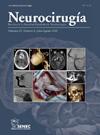“短节段腰椎融合术”与“单侧入路显微外科双侧减压术”对邻节段疾病患者脊柱固定架拆除后的临床回顾性研究
IF 0.8
4区 医学
Q4 NEUROSCIENCES
引用次数: 0
摘要
介绍和目的腰椎融合术后发生邻段疾病(ASD)的病例,可采用多种手术入路。在这种情况下,去除内固定可以积极影响腰痛综合征。一种常用的方法是短节段固定减压(SSFD)。经单侧入路显微外科双侧减压(MBDU)是微创方法之一。本研究旨在通过比较去除内固定后SSFD和MBDU,确定哪种方法在融合手术后发生ASD的病例中更有效和安全。方法回顾性分析47例SSFD和29例MBDU的临床资料。分析各组患者的性别、年龄、术前症状持续时间、住院时间,以及术前和术后间歇随访期间视觉模拟量表(VAS)评分和Oswestry残疾指数(ODI)评分。结果SSFD组住院时间高于MBDU组(p = <;0.001 CI分别为56,42 - 76,24和22,04 - 25,13),SSFD组减压段平均横管径比低于SSFD组(p = 0,03 IC = 0,24 - 0,31, MBDU组为0,40 - 0,47),所有随访SSFD组ODI指数均高于MBDU组(p = <0.001)。随访期间,SSFD组47例患者中有3例出现症状性ASD,而MBDU组未出现症状性ASD。结论在选择的融合术后发生ASD的患者中,去除内固定后MBDU可以被认为是一种微创选择,不会加重术后腰痛综合征或导致新的ASD的发展。据我们所知,这是文献中首次比较这两种技术在腰椎ASD病例中移除脊柱固定架后的效果。本文章由计算机程序翻译,如有差异,请以英文原文为准。
“Short-segment lumbar fusion” vs.“microsurgical bilateral decompression via unilateral approach” after removal of the spinal fixators in patients with adjacent segment disease: Clinical retrospective study
Introduction and objectives
In cases where adjacent segment disease (ASD) develops following lumbar fusion surgery, various surgical approaches can be employed. In such cases, removal of the instrumentation can positively impact lumbar pain syndrome. One frequently used method is short-segment fixation-decompression (SSFD). One of minimally invasive methods is microsurgical bilateral decompression via unilateral approach (MBDU). This study aims to determine which method is more effective and safe in cases that developed ASD following fusion surgery by comparing SSFD and MBDU after instrumentation removal.
Methods
A retrospective analysis was conducted on 47 cases treated with SSFD and 29 cases treated with MBDU. The groups were analyzed for gender, age, preoperative symptom duration, duration of hospitalization, and Visual Analogue Scale (VAS) scores and Oswestry Disability Index (ODI) scores during the preoperative and postoperative intermittent follow-up periods.
Results
Duration of hospitalization was higher in the SSFD group compared to the MBDU group (p = <0.001 CI = 56,42–76,24 and 22,04–25,13 respectively), mean transverse canal diameter ratio in the decompressed segment was lower in the SSFD group (p = 0,03 IC = 0,24–0,31 for SSFD y 0,40–0,47 for MBDU), and ODI indices were higher in the SSFD group in all follow-ups (p = <0.001). During the follow-up period, symptomatic ASD was observed in 3 of 47 patients in the SSFD group, whereas no symptomatic ASD was observed in the MBDU group.
Conclusion
In selected patients who develop ASD after fusion surgery MBDU after instrumentation removal can be considered as a minimally invasive option that does not exacerbate postoperative lumbar pain syndrome or lead to the development of new ASD. To the best of our knowledge, this is the first comparison of these two techniques in literature after removal of spinal fixators in lumbar ASD cases.
求助全文
通过发布文献求助,成功后即可免费获取论文全文。
去求助
来源期刊

Neurocirugia
医学-神经科学
CiteScore
1.30
自引率
0.00%
发文量
67
审稿时长
60 days
期刊介绍:
Neurocirugía is the official Journal of the Spanish Society of Neurosurgery (SENEC). It is published every 2 months (6 issues per year). Neurocirugía will consider for publication, original clinical and experimental scientific works associated with neurosurgery and other related neurological sciences.
All manuscripts are submitted for review by experts in the field (peer review) and are carried out anonymously (double blind). The Journal accepts works written in Spanish or English.
 求助内容:
求助内容: 应助结果提醒方式:
应助结果提醒方式:


